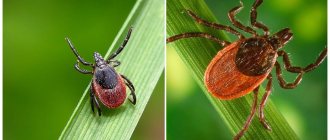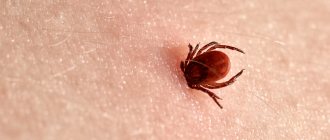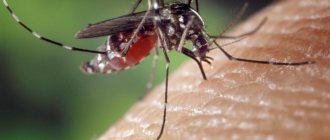Mosquitoes live on every continent of the world except Antarctica. These blood-sucking animals are carriers of various serious diseases - malaria, Zika virus, Dengue fever and others. They all have one thing in common - they are transmitted through blood. In this regard, a completely logical question arises: Is it possible to get AIDS from a mosquito? Despite the fact that during the period of laying eggs, female mosquitoes need to feed on the blood of people and animals, they are not carriers of the disease. It is impossible to become infected after a mosquito bite, even if it drank the blood of a virus carrier.
What diseases do bloodsuckers infect?
In the tropics, after being bitten by parasites, a huge number of people die from the infections they carry. Blood-sucking insects lead to severe damage to internal organs, paralysis, and death. Not all infections that tropical mosquitoes infect people have been treated with effective medications.
Mosquitoes carry the following diseases:
- Malaria. It is spread by female malaria mosquitoes, which are found not only in the tropics, but also in the south of Russia.
- Yellow fever. The disease is carried by mosquitoes living in Africa and Central America. No special therapeutic drugs have been developed against it yet. In severe cases, yellow fever causes the death of the patient.
Bloodsuckers also infect people:
- dengue fever;
- Japanese encephalitis;
- chikungunya.
People vacationing in tropical countries need to be careful: use mosquito repellents and seek medical help at the first symptoms of the disease. If the illness appeared after returning to Russia, then it is necessary to warn doctors about vacationing in the tropics.
Features of HIV infection
Acquired immunodeficiency syndrome is a very complex and insidious disease. Even after contracting HIV, a person may not get sick for several years, but years later, the disease makes itself felt.
In this case, the patient develops new infections against the background of weakened immunity. As a result, AIDS can lead to irreversible processes, deadly illnesses and even oncology.
The immunodeficiency virus itself, once released into the external environment, is soon deactivated and completely dies.
Carrying out a blood test
High temperatures, severe frost, and disinfectants can kill it. In a drop of blood that is placed in a test tube, the virus lives for a couple of days.
The source of transmission of infection is only humans. In patients, the HIV virus is contained not only in the blood, but also in semen and other internal secretion fluids, including breast milk. Infection occurs precisely through contact with hazardous substances. At the same time, the virus lingers in other biological components, but not for long.
The disease triumphs in the new body if a dangerous infection gets directly onto mucous membranes, open wounds or into the bloodstream. It is impossible to get sick in any other way.
dispelling myths about the modes of transmission of AIDS
That is why it is not forbidden to shake hands and even kiss someone with AIDS.
Methods of infection
You should not think that AIDS is a legend created to frighten young people and aimed at ensuring that boys and girls lead a healthy lifestyle.
HIV is a real threat to humanity. You can protect yourself from it not only by arming yourself with knowledge, but also by getting used to taking the necessary precautions.
You should refrain from unprotected sex with unfamiliar partners. Today, according to medical statistics, 40% of AIDS cases are contracted this way.
Your future may depend on this choice
At the same time, women are at greater risk of infection than men due to the physiological characteristics of the body.
Infection can occur from a sick mother to her baby during childbirth or during breastfeeding.
Transmission of the disease from mother to baby
This route of transmission of the disease is possible only if the pregnant woman was not registered at the antenatal clinic or refused to carry out the necessary procedures while carrying the child. If you do everything to prevent it from becoming infected, in 99% of cases the baby is born healthy.
A drug addict's needle - this is how several people become infected when using syringes at the same time.
Infection through a syringe
However, in the modern world, when injection drugs have ceased to be relevant, and they have been replaced by “salts” and other synthetic substances, the route of transmission of AIDS through a drug addict’s needle is less and less identified by doctors.
Above are the main 3 types of transmission of this terrible disease. But there are a number of other important points that should be taken into account when protecting yourself from danger:
- Blood transfusion not under proper conditions.
- Carrying out operations in dubious clinics.
- Through contaminated instruments in nail and tattoo parlors.
You should not trust your health and life to dubious clinics and doctors. It is important to remember safety precautions.
Do mosquitoes carry HIV?
When AIDS began to spread, it was suggested that the immunodeficiency virus could be transmitted by blood-sucking insects. But further research did not confirm this information.
Mosquitoes cannot transmit HIV infection because the virus cannot live outside the human body. If an insect sucks the blood of a sick person, the viruses will immediately die in his stomach.
Some people fear that a mosquito that has drunk the blood of a sick person will inject it into a healthy person. This is not possible for the following reasons:
- Having sucked the blood of one person, the female mosquito does not fly to bite another. She hides in a secluded place and digests food for several days, and then looks for a pond to lay eggs.
- Even if we assume that after swallowing the blood of a sick person, a mosquito will immediately fly to another, it will not be able to inject blood into him. The bloodsucker's proboscis works in one direction. The insect injects its victim only saliva, in which the immunodeficiency virus cannot exist. In this way, it differs from malaria plasmodia, which pass from the insect’s stomach to its salivary glands, and then, together with saliva, enter the human body and cause disease.
Several studies have been conducted on the transmission of AIDS by blood-sucking insects, but they have not confirmed this possibility. The immunodeficiency virus spreads sexually, through the blood, and passes through the mother's placenta to the child. There are no other routes of transmission.
Why can't mosquitoes carry HIV?
Few animals on Earth inspire as much antipathy as mosquitoes. Their itchy, irritating bites and almost ubiquitous presence can ruin your summer vacation. They have the uncanny ability to sense our sinister intentions to eliminate them, fly away and disappear milliseconds before the killing blow. And their continuous, squeaky sound can awaken the deepest sleepers.
In addition, mosquitoes are carriers of many notorious infections, such as malaria, dengue fever, Zika and Chikungunya viruses. It is estimated that mosquitoes transmit a disease to more than 700 million people each year, leading to many deaths. These disease outbreaks are most often observed in Africa, Asia, and Central and South America [1]. As a result, these bloodthirsty insects kill more people per year than any other animal. Fangs and claws lose to the small, squeaky bloodsucker.
A typical dipteran representative of the blood-sucking mosquito family (Culicidae) at breakfast
Fortunately for humans, HIV is not carried or spread by mosquitoes, otherwise we would be witnessing the most terrible apocalyptic nightmare, rivaling the fantasy of Hollywood directors. This phenomenon is explained by several reasons.
1. The structure of the mouthparts of mosquitoes.
Professor Wayne Krans of Rutgers University, New Jersey aptly noted that “mosquitoes are not flying hypodermic needles.” The type of structure of their oral apparatus is piercing-sucking. A mosquito's "proboscis," the needle-like part, is actually made up of six mouthparts. Four of them are used as stilettos to pierce the skin of a person or animal that is bitten by a mosquito. The other two parts resemble two channels that do not communicate with each other. Through the canal of the upper lip, food is carried out, and the elongated hypopharynx (lower canal) is responsible for the introduction of saliva into the puncture. This two-channel system, due to the isolation of each part, is one of the reasons why mosquitoes cannot transmit HIV [2].
2. The HIV virus dies in the mosquito's intestines.
HIV is unable to multiply in the mosquito's intestines and is therefore destroyed. In humans, HIV infects CD4+ cells and begins to replicate in them. There are no cells with such a marker in the mosquito intestine, that is, there is no substrate, so the virus cannot continue its life cycle or migrate to the salivary glands. Thus, HIV particles are digested by mosquitoes along with the “bloody food” itself and the virus is completely killed [3].
3. Insufficient concentration of HIV in human blood.
For mosquito-borne viral diseases to be transmitted from person to person, the infectious agent must circulate in the host's blood at a sufficiently high level. HIV is contained in a person’s blood in a much lower concentration than is necessary to create a new infection in the conditions of a bite. If a mosquito injects HIV-positive blood into a person (although this is impossible for reasons 1 and 2), then it would take ten million mosquito bites to transmit one unit of HIV. By comparison, people infected with HIV typically carry no more than ten units of HIV. Accidentally swallowing or squashing a mosquito also cannot lead to HIV infection. In these situations, the mosquito still does not contain enough HIV-positive blood to cause a new infection [4].
HIV transmission can only occur if four specific conditions are met. If any of them are not met, the probability of infection is considered extremely insignificant and close to zero:
- The virus must be present in a body fluid in which it can replicate (blood, semen, pre-ejaculate, vaginal, cervical and rectal secretions, breast milk). This does not occur in tear fluid, cerebrospinal fluid, saliva, urine, sputum, sweat and feces;
- There must be a route through which HIV can easily enter the body through damaged mucous membranes or by direct entry into the bloodstream. It is extremely sensitive to external influences;
- HIV is tropic for the CD4+ cell receptor, which explains its ability to infect cells bearing this receptor. The virus must be able to reach such CD4+ cells in the body - this requires deep damage to the skin and/or absorption of the virus through the mucous membranes. HIV cannot pass through intact skin, and the skin itself does not contain susceptible cells. Similarly, in the gastrointestinal tract and respiratory tract the number of such cells is extremely small (plus the low concentration of the virus in sputum, urine and feces), so airborne and fecal-oral transmission mechanisms do not occur;
- A sufficient number of HIV particles is required. For example, the lower the viral load of a particular patient, the lower the risk of infection. An HIV-infected person is most dangerous at the late stage of incubation and during primary clinical symptoms [5].
Since mosquito bites do not meet any of these conditions, transmission of HIV through this route is considered impossible.
Bibliography:
- Watkins J., Baulch E. Identifying Grassroots Opportunities and Barriers to mHealth Design for HIV/AIDS Using a Communicative Ecologies Framework. 2022. In: Baulch E, Watkins J, Tariq A, editors. mHealth Innovation in Asia: Grassroots Challenges and Practical Interventions [Internet]. Dordrecht: Springer; 2022. Chapter 5. Available from https://www.ncbi.nlm.nih.gov/books/NBK543538/.
- Kikuchi K., Stremler M.A., Chatterjee S., Lee W.K., Mochizuki O., Socha J.J. Burst mode pumping: A new mechanism of drinking in mosquitoes. Sci Rep. 2018;8(1):4885.
- Pingen M., Bryden SR, Pondeville E., Schnettler E., Kohl A., Merits A., Fazakerley JK, Graham GJ, McKimmie CS Host Inflammatory Response to Mosquito Bites Enhances the Severity of Arbovirus Infection. Immunity. 2016 Jun 21;44(6):1455-69.
- Abdool Karim SS. HIV-1 Epidemic Control - Insights from Test-and-Treat Trials. N Engl J Med.(2019);381(3):286-288.
- Day T., Mideo N., Alizon S. Why is HIV not vector-borne? Evol Appl. (2008);1(1):17-27.
- https://www.bbc.com/news/health-48464510
The danger of mosquito bites
In Russia, cases of dengue or malaria are rare. The only danger mosquito bites pose is allergic reactions. They are caused by insect saliva, which contains substances that prevent blood clotting.
For most people, mosquito bites cause itching and small swelling. In babies under one year of age and in people with a strong tendency to allergies, blisters form, accompanied by itching and fever. In severe cases, anaphylactic shock is possible.
It is impossible to contract AIDS through a mosquito bite. If the parasite sucks the blood of a sick person, the virus will die in his stomach. Even if a person kills a mosquito with his bare hand, he is not in danger of getting sick.
Possibility of hepatitis infection
Diseases transmitted by mosquitoes are similar in symptoms to viral hepatitis, which affects liver cells and leads to liver atrophy. The disease is transmitted through blood, less often through sexual contact; hepatitis A is transmitted through dirty hands or contaminated products. Harm from mosquito bites is not associated with the spread of the virus. The patient experiences more severe allergy symptoms after an insect attack due to a weakened immune system.
How dangerous mosquito bites are depends on what part of the world you are analyzing. In total, there are more than 3 thousand varieties of these insects, the most dangerous ones live in the tropics and jungles with a hot, humid climate. Bloodsuckers do not transmit hepatitis or AIDS.
↑ Drugs for HIV/AIDS and side effects from them
In most cases, side effects from taking recommended medications are minimal. But a person who seeks help from a doctor already at the 4th stage of the disease, which is very common in our country, with a CD score of less than 200 due to the depression of his immune system, which persists while taking medications, may develop the so-called restored syndrome. immune system. At the same time, exacerbations of certain diseases may develop, including candidiasis. In such cases, patients are prescribed symptomatic treatment. In the process of gradually getting used to the prescribed therapy, the human body begins to gradually recover to its previous level. Therefore, it is the timely and earliest possible detection of HIV infection that is so important.
↑ How likely is it to actually get infected with HIV through a condom?
The vast majority of modern condoms provide protection against infection with HIV and other STDs at the level of 97, 98 percent.
But nothing more! The remaining small percentage refers to those cases where the condom was either mechanically damaged in some way before or during direct sexual contact, or was not put on securely enough, or was not correctly selected for the size of the partner’s penis. Most modern condoms are more durable. And few people succeed in tearing or tearing them, not even by accident, but intentionally during sexual intercourse. This risk seems especially strange, given the intended use of a condom during sexual contact between people, which is primarily aimed at obtaining pleasure, simultaneously combined with the goal of minimizing the risk of possible transmission of a whole “bouquet” of STDs from partner to partner.
In any case, you need to use a condom carefully and responsibly in order to minimize the likelihood of unforeseen circumstances arising in any way related to the risk of not only transmitting an STD, but also becoming pregnant.
The strength of each batch of condoms is laboratory tested in production. For this purpose, there are special test models of male and female genital organs and other instruments that allow us to verify with a sufficient degree of reliability the strength and reliability of each batch of condoms for their future buyers.
The price, design, aromatic and other design of condoms are purely marketing decisions of manufacturers aimed at popularizing their own products to increase demand for them, as well as profits from their sales. No more. At the same time, you clearly should not give preference to the cheapest condoms, because they are highly likely to be less durable, reliable, and of less quality.
↑ Who has a higher risk of contracting HIV infection? And why?
The risk zone for an increased likelihood of contracting HIV infection traditionally includes women providing commercial intimate services, gay and lesbian couples, users of injecting drugs; in a number of regions of Russia, seasonal workers face an increased risk of infection.
What should you do if a person still has a positive HIV test on their hands after taking the test? After all, the possibility of a laboratory error is also not excluded?
Still, it doesn’t happen all at once. Before the test, a person first undergoes a consultation with a specialized doctor, during which the person is prepared for a specific diagnosis. If the HIV test is confirmed, the person undergoes a second, but post-test, consultation with a doctor, during which the patient is prescribed a series of laboratory tests to identify pathologies associated with HIV infection in the body.
A certified doctor has the right to confirm or refute a previously made diagnosis, referring the patient, if necessary, for a re-examination. In addition to this, the doctor can determine in more detail the stage of development of this disease, the need for prevention of opportunistic diseases, which in most patients with HIV infection include tuberculosis, bacterial infections, Pneumocystis pneumonia, herpetic infections (shingles, herpetic infections, caused by HHV-1, HHV-2 and HHV-5), candidal esophagitis, cryptococcal meningitis, toxoplasmosis. A broader list of opportunistic diseases includes bacterial respiratory and intestinal infections, atypical mycobacteriosis, bartonellosis, fungal infections (candidal esophagitis, cryptococcosis, histoplasmosis, Pneumocystis pneumonia, coccidioidomycosis or coccidioidomycosis), viral infections such as those caused by herpetic viruses, papillomavirus human, hepatitis B and C. The Ministry of Health lists toxoplasmosis, cryptosporidiosis, isosporosis, and leishmaniasis as parasitic infections. Other diseases associated with HIV infection include Kaposi's sarcoma, non-Hodgkin's lymphoma, cervical cancer, HIV encephalopathy, vacuolar myelopathy and progressive multifocal leukoencephalopathy. It is worth noting separately that it is Kaposi's sarcoma that consistently ranks first in the list of malignant neoplasms affecting people with HIV infection.
If urgent treatment is necessary for the patient, he is immediately prescribed a course of antiretroviral therapy, which is an integral element of the treatment of HIV-infected people. Only by following a course of such therapy can a person diagnosed with HIV be able to live a normal and full life due to sufficient suppression of the immunodeficiency virus. Against the background of suppression of HIV activity, the existing capabilities of the immune system are activated. And only in this way can a person infected with HIV live without developing other diseases or pathologies associated with HIV infection.
↑ More details about viral load and CD4 indicator
This CD4 indicator is most important when determining the grounds for starting and stopping prophylaxis for opportunistic diseases, as well as for assessing the degree of urgency of antiretroviral therapy.
At the same time, due to the widespread use of antiretroviral therapy for patients diagnosed with HIV, regardless of viral load indicators and available CD4 lymphocyte counts, additional determination of the CD4 index along with viral load before starting antiretroviral therapy is not considered necessary.
Among patients with chronically drug-supported suppression of the viral load and partial restoration of their immune system due to completion of a prescribed course of antiretroviral therapy, the CD4 lymphocyte count indicator turns out to be of little information.
↑ Rapid tests and laboratory tests for HIV, their comparative accuracy, reliability, efficiency
The reliability of the HIV rapid test from the vast majority of manufacturers of such pharmaceutical medical products is 99 percent.
But you obviously shouldn’t forget about the remaining 1 percent. Therefore, when conducting such rapid tests for HIV and in case of receiving a positive answer, the standard practice of specialized medical centers involves taking the test again, but from a different manufacturer of test systems, in order to eliminate the possibility of error. Upon repeated confirmation of the presence of HIV infection in the examined patient, he is diagnosed with HIV. If necessary, an additional enzyme-linked immunosorbent assay is carried out, which can show the final result no earlier than several weeks after the samples are taken, determining the presence in the body not of the human immunodeficiency virus itself, but of antibodies to it. Some people develop antibodies within two weeks, while others may develop them much later. Or, the technique of immunoblotting is used as an analytical method to determine the presence of specific proteins in the test sample. This method is based on a combination of simultaneously used electrophoresis and ELISA or RIA techniques. At the first stage of immunoblotting, protein electrophoresis in a polyacrylamide gel is used to separate denatured polypeptides by their length, most often using SDS - sodium lauryl sulfate (SLS) or sodium dodecyl sulfate (SDS), which is the sodium salt of lauryl sulfuric acid, an anionic surfactant. Or the determination occurs based on the three-dimensional structure of the protein, which is important, in its native state. At the next stage of the study, the proteins are transferred to a nitrocellulose or polyvinylidene fluoride (PVDF) membrane. This is done for their subsequent detection using antibodies specific to the initially specified type of protein. The demand and accuracy of this research technique is confirmed by the established pharmaceutical production of antibodies to tens of thousands of different proteins.
Repeated testing for HIV allows you to verify the presence of this disease in a particular person due to additional confirmation of the results of a preliminary study of samples taken for the presence of HIV.
↑ Certificate of absence of HIV from your partner - a guarantee of safety?
No.
Only in some cases. This is especially true given the possibility of obtaining virtually any certificate from us. Therefore, such a certificate easily turns into an empty piece of paper. However, it’s clearly not worth rushing to extremes here, because the vast majority of people already believe that this problem will definitely not affect them. Based on this, they refuse to periodically visit doctors and undergo the necessary set of tests. And the threat of contracting AIDS actually concerns every person, not only leading a regular sex life, but also visiting that dentist or cosmetologist. If you think that this is not about you, then you can only sympathize with you. Every person thinks so, but only until he or she becomes infected with HIV.
Early detection of the virus is critical to minimizing the risk of onward transmission of HIV to other people with whom you have sex or other close contact. It is for this reason that every person really needs to regularly undergo a scheduled examination by a venereologist, gynecologist, or urologist, passing the necessary set of tests for the timely detection of HIV and the causative agents of other STDs.
↑ Viral load and CD4 count
The viral load, together with the number of CD4 T-lymphocytes, is an indicator of the response of the HIV-positive person to ongoing antiretroviral therapy and the current progression of HIV infection.
The viral load indicator turns out to be most useful and informative after the start of antiretroviral therapy.
Quantitative determination of the CD4 indicator is used to confirm the effectiveness of prescribed antiretroviral therapy. At the same time, determining the viral load allows you to obtain more accurate and informative data.
Determining the actual CD4 count as accurately as possible is most important and useful before initiating antiretroviral therapy. The lymphocyte count (CD4) provides more accurate information about the current state of the patient's immune system.











